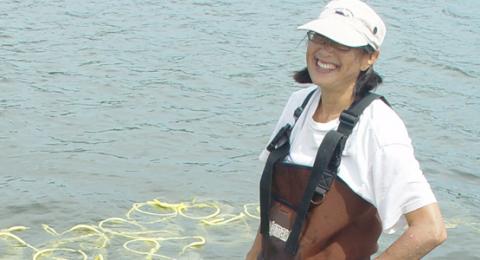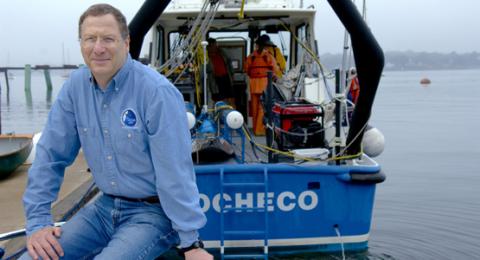The major disciplines of oceanography are geological oceanography, physical oceanography and chemical oceanography. Oceanographers and others involved in these disciplines often work together to unravel the mysteries and unknowns of ocean science.
In reading about each of these sub-fields, keep in mind that some of the most important oceanographic discoveries have been made as a result of an integrated, multidisciplinary approach, often involving geologists, chemists, biologists, physical oceanographers and engineers.
Marine biology is sometimes called biological oceanography and could be included in this section. We have not done that. One distinction that has been made between the fields of marine biology and biological oceanography is this: marine biologists study the plants, animals and protists of our estuaries, coasts and oceans, ranging from whales to microscopic algae and bacteria, and biological oceanographers study marine organisms and their biological processes within the context of their natural environment.
As a growing global population stresses the ability of our society to produce food, water and shelter, we will continue to look to the oceans to help sustain our basic needs. Advances in technology, combined with demand, will improve our ability to derive food, drinking water, energy sources, waste disposal and transportation from the ocean. It will be up to this and future generations to build upon our existing knowledge of the ocean and its potential to help meet the needs of the world and its inhabitants.
Monique LaFrance, an oceanographer profiled on this website, describes her work this way: “Collecting data and figuring out how data relates to each other is like putting together pieces of a puzzle. It is extremely rewarding when you know your work has direct application to an important effort. For me, it is when final habitat maps and findings can be put to good use -- such as contribute to a better understanding of the ecosystem, identify physical-biological relationships, inform management decisions, and further methodologies used in the field of seafloor habitat mapping. I also very much enjoy using ArcGIS mapping and spatial analysis software and being out on research vessels to conduct fieldwork.”
Geological Oceanography
As many interesting geological features as there are on land, nearly as many exist within, under, and at the boundaries of the oceans. Mountains, valleys, volcanoes, islands, plains and canyons all exist in similar form in the marine realm. In fact, Earth's largest continuous mountain chain is the Mid-Ocean Ridge, stretching for over 40,000 miles and rising above the surface of the water in a few places, such as Iceland. The Mariana Trench, located in the central Pacific Ocean, is deeper, by about a mile, than the highest point of Mount Everest. Active deep-sea volcanoes, located along mid-ocean ridges, supply rich mineral deposits and new rock formations to the seafloor. It has been written that the ocean bottoms are the most active places on Earth, from a geological perspective.
Geological oceanographers study the formations, composition and history of the seafloor. They examine sediments, including physical characteristics such as size, shape, color and weight; chemical characteristics, such as composition and how sediments interact with the environment; and other factors, including sediment age, origin, distribution and transport. They piece together information about how the Earth formed and how the movement of plates and continents results in events such as volcanoes and earthquakes. They work with biologists and chemical oceanographers to learn more about historical climate records and animal and plant life by examining sediment and rock cores for fossils and analyzing sediment composition using radiocarbon dating and other methods. They also use remote sensing technology to map the ridges and valleys.
An increasingly important area of marine geology is coastal geology. Throughout history, the human population has shown a tendency to settle along the world's 273,000 miles of coastline. The effects of humans inhabiting our shores and coastlines have become increasingly apparent. Coastal pollution and waste disposal are creating problems and costing government and industry billions of dollars in research and remediation efforts. Although the percentage of people living on the coast is expected to remain fairly constant over the next few decades, total numbers are expected to increase as population continues to increase.
In addition to human effects on our shores, natural coastal processes such as rising sea level, erosion and sediment transport, and storm-related events such as flooding, severe erosion and storm overwash make our coastal areas dynamic environments. Often, humans react by attempting to protect structures situated along the coast, including homes, businesses and roads, even when these structures are located on land forms, such as barrier beaches, that are "temporary" in a geologic sense of time. To protect these structures, coastal engineers have developed and constructed seawalls, jetties, groins and bridges. More recently, natural or "soft solutions" such as constructed wetlands and salt marshes have been developed to slow the effects of coastal processes. Coastal geologists and coastal engineers, working with oceanographers from each of the disciplines, will be instrumental in forming policy and management options to minimize the conflicts between coastal development and natural processes.
Physical Oceanography
Most oceanographers try to think of the world's oceans as one giant system, collectively known as the global ocean. But before space travel and the invention of satellites, it was very hard to actually observe the oceans on such a large scale. Pictures of the global ocean from space have given oceanographers important information about ocean currents, temperatures and other properties. Satellites collect information around the clock and feed it back to earth -- and individual laboratories and classrooms -- in real time. This innovation has revolutionized oceanography and given researchers important information about weather and climate, circulation, and environmental problems such as global warming, global circulation, the world's fisheries decline and harmful algal blooms.
Perhaps more than any other group of oceanographers, physical oceanographers have benefited from satellite technology. Because they study the movement of the oceans and the forces that cause motion, such as winds, waves and tides, they must look at the ocean from a "big picture" perspective. Shipboard measurements and the development of instruments such as computer programmable buoys that can be left at sea for long periods of time were huge advances for the field of physical oceanography and continue to be important tools, but satellites offer perspectives that early oceanographers may never have dreamed of.
Physical oceanographers study the interaction between the ocean and its boundaries -- land, seafloor and atmosphere -- and the relationship between the sea, weather and climate. Questions about how the oceans work in a physical sense include investigations into water qualities such as temperature, salinity and density, and influential factors such as wind speed, air temperature, tides and interaction with nearby land and underwater formations.
Physical oceanographers seek to understand why, where and how water moves, on all space and time scales. They are interested, too, in the consequences of these movements. Some physical oceanographers are theoreticians and use computer models to answer questions and form hypotheses about oceanographic processes. Others use observations and, increasingly, satellite observations. Understanding the global ocean requires a close partnership between theory, observations and experiments.
Often, physical oceanographers work with their biological, chemical and geological colleagues. Understanding the way the ocean works, physically, supplies oceanographers in the biological, geological, chemical or engineering disciplines with important details they need to answer questions. The physical properties of the ocean are intimately linked to the biology and chemistry of the ocean, and vice-versa.
Chemical Oceanography
The ocean has been referred to as a "chemical soup" because it contains many chemical compounds, elements, gases, minerals, and organic and particulate matter. While water is the most plentiful ingredient, salts are among the most important. Amazingly, despite the major changes that have taken place on Earth throughout history -- continental collisions, land formations, glaciation -- the basic composition of seawater has remained relatively constant for millions of years.
Chemical oceanographers, also called marine chemists, marine geochemists, or even marine biogeochemists, may study one or a combination of the following: formation of seawater and seafloor sediments, relationships between chemical compounds (both organic and inorganic), how chemical inputs to the ocean (including pollution) affect it, and how the chemistry of the ocean affects or is affected by biological, geological, and physical factors. As with the other disciplines of oceanography, chemical oceanographers rely on and interact with researchers from the other disciplines.
One important aspect of chemical oceanography is the study of pollutants. This work may lead chemical oceanographers to the deep ocean, coastal bays and estuaries, or inland rivers, streams and lakes. Sources of pollutants range from the obvious (sewage, oil or fuels, ocean dumping) to sources that are harder to detect or trace (agricultural or lawn runoff containing chemical fertilizers, leaking septic systems, road runoff or storm drain overflows). Chemical oceanographers study the impact of such pollutants by examining how they interact with seawater, marine life and sediments. Chemicals and pollutants introduced to a marine environment may behave very differently depending on environmental conditions such as salinity, wind, rainfall, temperature and transport methods. Transport methods include land-based (for example, surface runoff or groundwater), water-based (rivers and streams), and atmosphere-based (rain and dust).
Modern society's rapid technological advances, including the development of complex chemical compounds and processes used to produce and manufacture energy, food, clothing, medicine and other products, have created a need for chemical oceanographers. In the quest for bigger, stronger and faster, the costs of "improvements" often get overlooked. For example, the disposal of waste that results from products and by-products can be a problem in itself. Who would have thought that household cleaning products, fertilizers, pesticides, boat paints and leaded fuel -- all products that saved time, worked better and often cost less -- could have contributed to the degradation of many marine and coastal areas? Fortunately, researchers in many oceanographic disciplines and related areas, including marine chemists, have worked together to improve our understanding of such impacts, which has, in turn, led to improved controls, regulations, testing methods and, ultimately, safer products.
The work of chemical oceanographers will continue to provide answers to important questions. For example, the use of the oceans for waste disposal and as a source for drugs and minerals will require cooperative research between ocean chemists, biologists and geologists. It is the work of marine chemists that aids ocean engineers in the development of instruments, vessels and ocean vehicles that, in turn, improve the ability of researchers of all oceanographic disciplines to go to sea, collect data and discover previously unknown formations, marine life and phenomena.
As the population discovers new ways to use the oceans -- be it for food, transportation, energy or waste disposal -- chemical oceanographers will play an important role in improving our knowledge about the impact of these activities on the ocean and its ability to sustain them.




